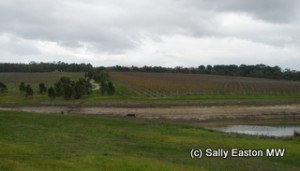Australia’s Little Italy
A shorter version of this article first appeared in Drinks International magazine in 2007.
Along with the continuing pinot grigio craze, the buzz around Italian varietals is extending to some rather serious reds, and it is Victoria, with its rich heritage of Italian migrants, that is leading the field on the Australo-Italian front.
Victoria is climatically and altitudinally diverse
Victoria may be smallest mainland state in Australia but it has the most different regions. Victoria is climatically and altitudinally diverse, with vineyards at almost sea level and heading up towards 1,000m above sea level.
Vineyard plantings are predictably dominated by the usual suspects: pinot noir, shiraz, chardonnay, cabernet sauvignon and merlot. These big five take up more than three-quarters of the Victorian vineyard, which, in fact leaves plenty of room for manoeuvre for other grape varieties.
Many of these other grape varieties were planted by the numerous Italian post-war migrants who had moved to Victoria initially to work in the tobacco industry. But as this work declined, vineyards grew up from the 1970s. And the diverse King Valley, home to many of these families, is the heart and soul of Victoria’s production of Italian varieties.
Which means some King Valley vineyards have a goodly amount of vine age, some up to 30 years old. Michael Dal Zotto, winemaker at Dal Zotto Estate said: “My father, Otto is from Veneto, my mother Elena from Trento. After meeting over here, they planted vines from their home area in 1987 – sangiovese, barbera, pinot grigio, arneis.”
Sangiovese and barbera are among the main Italian varieties worthy of note, alongside nebbiolo and pinot grigio. More esoteric varieties include arneis, brachetto, marzemino, prosecco and verduzzo.
Australia’s 2025 strategy for the promotion of the country’s wines should be good news for Victoria. The Victorian Wine Industry Association’s chief executive, Joanne Butterworth-Gray, set a priority to promote Victoria as a “regional hero” (one of the threads of the strategy), as well as the individual regions within Victoria as regional heroes. She said, “for example Beechworth has six or seven wineries with an artisan sense of self, yet Giaconda is there. Bendigo is playing on its gold history, and producing rich, ripe reds. Mornington is pinot noir”, and not forgetting pinot grigio in the Italian varietal theme.
Pinot grigio: Mornington and beyond
Though pinot gris/grigio is grown pretty much throughout Victoria, the Mornington Peninsula has a quarter of all the state’s plantings, though this sum accounts for fewer than 10% of the peninsula’s total plantings.

Mornington Peninsula
The taxonomy is currently ad hoc, with some producers labelling pinot gris and others pinot grigio, and not always according to the styles anticipated in a European context. Generally, though, whole bunch pressing, solids and oak are often used during vinification in the ‘gris’ camp. For example, the 10X pinot gris from Ten Minutes by Tractor uses eight year old oak, wild yeast “for complexity and texture” said owner Martin Spedding, and has a hint of residual sugar on the spicy back palate.
The Kooyong pinot gris is whole bunch pressed to oak for a natural fermentation. Winemaker Sandro Mosele said: “there’s no battonage, but we ferment with solids. There’s no malolactic fermentation – whites need to be driven by acidity. “
King Valley Core
It is in the King Valley though, where Brown Brothers was one of the pioneers for Italian varieties, in the 1970s, working with growers, many of whom had moved from northern Italy. Ross Brown their CEO said: “There’s been a progressive shift. People want to try something different. Italian varietals offer such a different flavour profile than cabernet sauvignon and shiraz” adding, “there’s good demand, and we’re more likely be planting Italian varieties.”
The also family-owned, but larger company, De Bortoli has made significant investment in Italian, and other, varietals. Export director Victor De Bortoli said: “my father, Deen, planted some different things. You’ve got to try these things.” Five to ten years ago the company was planting the likes of pinot noir and pinot grigio.
Given their size, the company’s portfolio is geographically segmented. Steve Webber, their manager and winemaker, said: “The common brand is De Bortoli, with sub-brands, from the Yarra Valley, from King Valley, from the Hunter Valley. People are interested in knowing where wines come from regionally.” Their Victorian-origin Windy Peak range has for several years had a sangiovese, and a pinot grigio is a recent addition to the UK portfolio, taking advantage of the seemingly infinite phenomenon that is pinot grigio.
But it is the Sero range, launched into the UK in 2006, which comes from King Valley. Webber said: “We liked the King Valley. It has excellent potential for Italian varietals, and we made a large commitment, of 500 acres (202 hectares). We’ve developed interesting wines around it [under the Sero label], which are medium bodied, with savoury rather than sweet oak. They might even go well with pizza!”
Among mainstream wine consumers there are not thought to be too many who realise sangiovese is the backbone of Chianti, or nebbiolo of Barolo, so De Bortoli is easing Italian varietals into consumers’ consciousness, by blending with more well-known varieties: syrah/dolcetto, chardonnay/pinot grigio; merlot/sangiovese. Webber said the Sero wines are “to quaff and enjoy. Don’t think about it. Drinkability and deliciousness.”

Pizzini Family
Fred Pizzini, director of Pizzini Wines, is one of those King Valley pioneers who used to provide fruit to Brown Brothers. He said “we started with a passion for sangiovese and nebbiolo, going back about 20 years. When we planted there was only us in Victoria. We set out from day one to let the variety express itself in King Valley.
On nebbiolo, Pizzini said: “the King Valley gives the ability for nebbiolo to be left on the vine into early April, for slow maturation. We get pure conditions from the Snowy Mountains directly behind us which allow the development of those fantastic aromatics that nebbiolo has to have. 1991 was our first vintage of nebbiolo; it’s only just starting for us in Australia.”
On sangiovese, Pizzini said “the [climatic] diversity of King Valley means we’ve selected warmer sites for it within our 200 acre (81 ha) site. We learnt from growing shiraz which looks for similar conditions. Both do very well.” About half their vineyard is now planted to Italian varietals, with more going into the ground.
The Aussies seem to favour barbera with some oak, especially old oak, as Pizzini explained: “The bugger’s too acidic, it needs a bit of oak to balance out the angles.” Mosele added their “Barbera is made with old oak. We wanted the extra level of complexity and suppleness in wine to soften the effect of the acidity.”
The Italian heritage has also spurred on Sam Miranda of King Valley. The King Valley winery was already in the Miranda family, before they sold the company to Simeon McGuigan [now Australian Vintage] in 2003, with the vineyard planted in the early 1980s. Miranda said: “The vineyard has different soils, heavier clay, red soils. You can match varieties to blocks. With 20 years history now we’re beginning to match variety with site. Sangiovese is one of the original varieties in the area; I’m looking to plant some next year.”
Esoterica
There’s also a lot of experimentation with (even) less well-known Italian varieties such as arneis, cortese, verduzzo and some bubblies. Pizzini said: “there’s lots of opportunity for white varieties, they work well in Australia. Aussies are looking for new things other cabernet and chardonnay, and for more food friendly styles of wine.”
It was Pizzini who made Australia’s first bracchetto, in the traditional style. With nearly 3 hectares of the Piemontese deliciously sweet, frothy, red wine style, the Pizzinis are happy it sells well, especially once people have tasted it. And dal Zotto said “we were the first in Australia to release a prosecco, in 2004, which has proven so popular we’re increasing plantings. We try to keep it true to style with a fine perlage, and fresh, crisp apple palate, and just a short time on lees.”
Why now?
The long, slow drip of education and trial seems to be reaching a critical mass. Pizzini said: “sommeliers played a big part in making things change – getting product into peoples’ mouths. Most people didn’t know that sangiovese is the basis of Chianti. So education, getting people to understand the styles are for food rather that everyday drinking, it’s a lot of little things that make up the picture of change.”
Miranda added “there’s a definite swing to wines with finesse, cool climate wines. There’s an undercurrent of people wanting to drink a bottle of wine and still be upright. Imports from Spain and Italy are really growing now. Up to 50% of some wine lists are European wines; people are a bit bored of Aussie fruit bombs.”
Further evidence for these winds of change was provided by the big boys in South Australia, when Jacob’s Creek dipped its toe in the Italian water with the inaugural 2006 vintage of Three-Vines rosé, which contains a little sangiovese. Similarly Yalumba have a limited release sangiovese rosé, under the ‘Y’ series. That Italian niche looks like it might just grow quite fast.
Victorian wine industry at a glance
- Wine story started n 1838 in Yarra Valley
- 2800 growers
- 21 wine regions
- Over 600 wineries (30% of Australia’s total)
- Over 200 wineries produce Italian varieties, with half of them producing more than just pinot grigio.
- 80% of wineries crush fewer than 100 tonnes (~6,000 to 7,000 cases)
- 36,579 hectares, plus 2400 planted, not yet bearing.
- Has 23% of the total Australia vineyard
- Has more than 30% of Australia’s pinot gris/grigio plantings
- 354,796 tonne crush in 2006 (-10% on 2005)
- Has 22% of total Australia crush
- Climatically and mesoclimatically diverse
Sources: www.winetitles.com.au; www.winesofvictoria.com.au
Victoria regions making a (small) impact with Italian varietals
Barbera: Heathcote, King Valley, Pyrenees
Nebbiolo: Goulburn Valley, King Valley, Yarra Valley
Pinot gris/grigio: Alpine Valley, Geelong, Heathcote, Henty, King Valley, Mornington, Strathbogie, Yarra Valley
Sangiovese: Alpine Valley, Goulburn Valley, King Valley, Pyrenees, Sunbury, Yarra Valley
Hectares of bearing vines |
||
|---|---|---|
| 2000-01 | 2005-06 | |
| Barbera |
26 |
44 |
| Nebbiolo |
9 |
24 |
| Pinot gris |
0 |
241 |
| Sangiovese |
51 |
91 |
| Zinfandel |
0 |
7 |
| Main Italian varieties sub total |
86 |
407 |
| Total Victoria plantings |
11,541 |
14,098 |
| Italian varieties as a percentage of total plantings |
0.7% |
2.9% |
- Excluding the pinot grigio phenomenon, red Italian grape varieties account for 1.2% of total Victoria plantings, a more than 70% increase since 2000-2001.
- In absolute terms the number of hectares dedicated to red Italian varieties has nearly doubled in five years.
Source: Victorian Wine Industry Association



